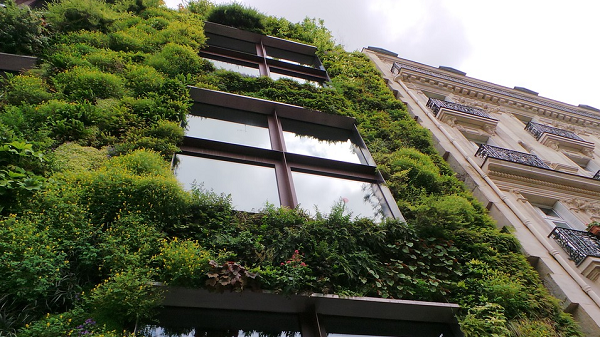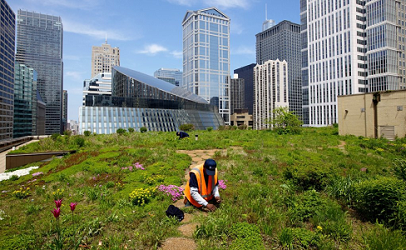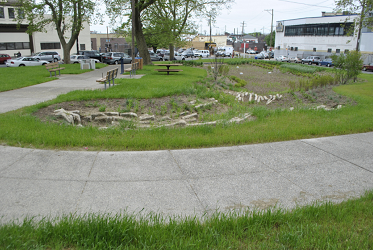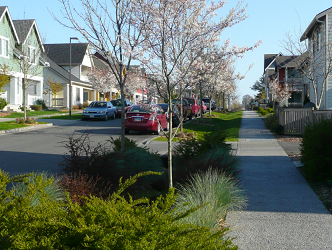
January 16, 2018, by lgzsam1
The Need for Multi-functional Design
In this blog, Dick Fenner examines how the multi-functional design of sustainable drainage systems can enhance the multiple benefits they can produce across an urban landscape.
Introduction
Urban drainage systems that incorporate elements of green infrastructure (SuDS/GI) are central features in Blue-Green and Sponge Cities. Such approaches provide effective control of stormwater management whilst generating a range of other benefits (e.g Wentworth, 2017) such as urban temperature regulation, improvements in air quality, carbon storage, habitat, amenity and recreational improvements and so on. However these benefits often occur coincidentally and are not developed or maximised in the original design. Of all the benefits that may accrue, the relevant dominant benefits relating to specific locations and socio-environmental circumstances need to be established, so that flood management functions can be co-designed with these wider benefits in mind to ensure both are achieved during system operation.
Three propositions need to be explored (Fenner, 2017):
Proposition 1: Multiple benefits from SuDS/GI assets emerge coincidentally
Systematic procedures for pro-actively developing drainage infrastructure to deliver a specified range of predetermined desirable multiple benefits are rare. A stronger justification for implementing SuDS/GI approaches can be made if a simultaneous and explicit case can be demonstrated for the wider multiple benefits they can achieve, rather than hoping that they may occur fortuitously once an asset has been installed.
Proposition 2: Agreement is needed on relevant dominant benefits
Not all benefits occur simultaneously, and some benefits may preclude the establishment of others (Hoang et al. 2016; Langmeyer et al. 2016) so that not all the multiple benefits from SuDS/GI are realisable all of the time. What is important is to establish a smaller subset of benefits that provide the greatest benefit uplift, uniquely agreed for each site’s location specific circumstances. In this way the dominant benefits which provide the greatest discernible change can be established. Tools to achieve this have been reviewed by Fenner (2017) and a novel spatial evaluation of SuDs benefits has been developed using concepts of benefit intensity and benefit profile (Morgan and Fenner, 2017) which can complement the monetization of multiple benefits in CIRIA’s BeST Tool (2015). A parallel activity would be to engage with local stakeholders to explore priorities and preferences so that the relevant benefits are identified in each location.
Proposition 3: Systems should be co-designed to deliver both a flood control function and wider multiple benefits
The purpose of refining the benefit evaluation is to create a positive feedback loop into the asset design (Figure 1). This will allow the principle drainage function of SuDS/GI to be co-designed with the delivery of the subset of relevant dominant benefits pertaining to site specific contexts and circumstances.
Figure 1: Positive feedback loop created using benefit evaluation
Examples of multi-functional design modifications for typical SuDS assets
Green streets (Figure 2) are frequently designed for stormwater management purposes, but they also have the potential to reduce air pollution through trapping on leaf surfaces. In areas that suffer from significant levels of PM10 air pollution due to the close proximity to high levels of road traffic, this potential for pollutant trapping may be considered as an important additional benefit. However the installation of street trees must be carefully designed and maintained to enhance, and not worsen, local air quality. Studies have shown that adding vegetation, especially trees, to hot-spots of air pollution (e.g. poorly ventilated areas along streets) can increase pollutant concentrations by further restricting air flow and exchange (Gromke and Ruck, 2012). Conroy et al. (2017) has shown the strategic placement and design of green infrastructure is necessary to enhance PM10 capture and to prevent the possibility of green infrastructure inadvertently worsening air quality. Recommendations include: adequate space between the tree crowns and nearby walls, tree height shouldn’t exceed the height of nearby buildings, and planting fewer trees is better (Vos et al. 2013). It is vital for stormwater and air quality researchers to determine the performance, optimal design, and best placement of vegetated stormwater control measures within green streets with regard to reducing PM10 concentrations.
Figure 2: Examples of multi-functional blue-green infrastructure features: green roof, stormwater swale and green street.
Urban green infrastructure usually consists of a fragmented mosaic of diverse smaller patches of vegetation with different uses within which large areas such as parks are set. Connecting such areas together in the form of urban corridors can have substantial benefits both in amenity terms and for the linear movement of wildlife. With some additional thought at the design stage some linear SuDS/GI schemes such as swales (Figure 2) might be marginally extended to provide the mechanism for linking these patches together. Co-designing SuDS/GI schemes to provide both a flood mitigation benefit and improved green space connectivity is a clear example of where multi-functionality can be achieved.
Hoang and Fenner (2015) showed the benefits that can accrue from green roofs (Figure 2) will be dependent on how the installations are managed. These benefits can include hydrological performance regarding runoff retention and storage, carbon sequestration, noise attenuation, building and urban cooling, pollutant trapping, food production, biodiversity and social and amenity benefits. However different functions of a green roof can prevail under different conditions. The main determining factors of these conditions are the heat and water budget of the roof. The functions have strong dependencies on soil moisture and characteristics of the vegetation and the soil cover. Also different green roof functions prevail under different physical conditions and that green roof functions may occur in phases or continuously. In particular, high soil moisture can diminish the functioning of noise attenuation, and limits the capacity for stormwater uptake but could enhance photosynthesis, carbon sequestration and heat exchange of the roof. The nature and density of planting are other important variables which can achieve different outcomes. So again an element of co-design is required to achieve the relevant dominant benefits required.
Conclusion
We argue that more needs to be done to pro-actively consider the wider outcomes and benefits that can provide multiple positive gains from the implementation of SuDS/GI solutions for urban drainage and urban flood mitigation. This will involve a systematic appraisal of which benefit opportunities offer the most potential gain in a given location, and meet the expectations and desires of local stakeholders. Such an approach will avoid such benefits being left to occur coincidentally or by chance and so maximise the case for the adoption of SuDS/GI assets by addressing the aims and goals across a wider urban planning framework. Tools that are being developed to evaluate the multiple benefits from SuDS/GI and applying these can identify relevant dominant benefits for each location and context specific circumstances. This can drive more effective co-design so that areas of truly multi-functional green space can be realised in many urban locations.
Dick Fenner is Professor of Engineering Sustainability at Cambridge University, working on the EPSRC Urban Flood Resilience project.
Dick would like to acknowledge the support of Lan Hoang, Malcolm Morgan and Leon Kapetas in the production of this blog.
The images used in this blog are labelled for non-commercial reuse.
References
- Wentworth, J. Urban Green Infrastructure Ecosystem Services; POSTbrief from UK Parliamentary Office of Science and Technology: London, UK, 26 July 2017.
- Fenner R.A. (2017) Spatial Evaluation of Multiple Benefits to Encourage Multi-functional Design of Sustainable Drainage in Blue-Green cities. Water 2017 9 953; doi:10.3390/w9120953
- Hoang, L.; Fenner, R.A.; Skandarian, M. Towards A New Approach for Evaluating the Multiple Benefits of Urban Flooding Management Practice. Flood Risk Manag. 2016, doi:10.1111/jfr3.12267.
- Langemeyer, J.; Gómez-Baggethun, E.; Haase, D.; Scheuer, S.; Elmqvist, T. Bridging the gap between ecosystem service assessments and land use planning through Multi-Criteria Decision Analysis (MCDA). Sci. Policy 2016, 62, 45–56.
- Morgan, M.; Fenner, R.A. Spatial evaluation of the multiple benefits of sustainable drainage systems. In Proceedings of the Institution of Civil Engineers, Journal of Water Management, June 2017. Available online: https://doi.org/10.1680/jwama.16.00048 ISSN 1741-7589|E-ISSN 1751-7729 (accessed on 6th December 2017).
- RP 993: Demonstrating the Multiple, Benefits of Suds—A Business Case; Ciria: London, UK, 2015. Available online: http://www.susdrain.org/resources/best.html
- Gromke, C.; Ruck, B. Pollutant concentrations in street canyons of different aspect ratio with avenues of trees for various wind directions. Layer Meteorol. 2012, 144, 41–64.
- Conroy, K.; Hunt, W.; Kumar, P.; Anderson, A. Air quality considerations for stormwater green street design. In Proceedings of 14th International Conference on Urban Drainage, Prague, Czech Republic, 10–15 September 2017.
- Vos, P.E.; Maiheu, B.; Vankerkom, J.; Janssen, S. Improving local air quality in cities: To tree or not to tree? Pollut. 2013, 183, 113–122.
No comments yet, fill out a comment to be the first





Leave a Reply